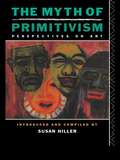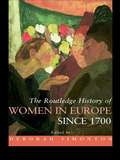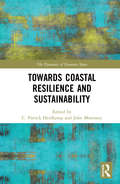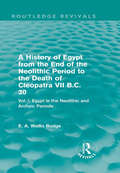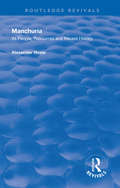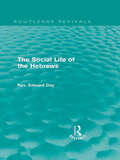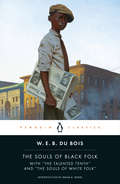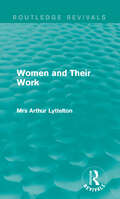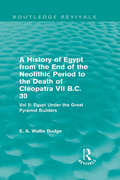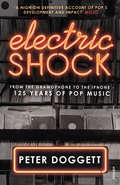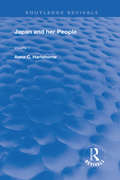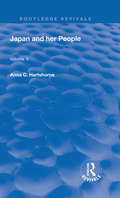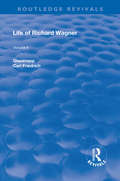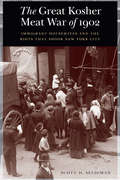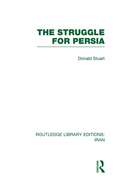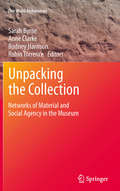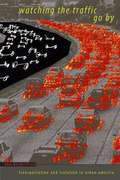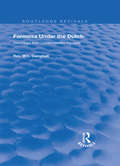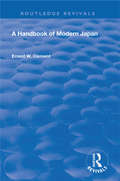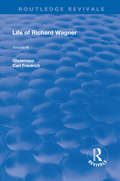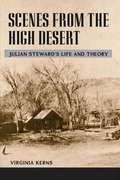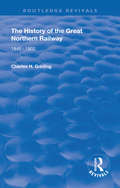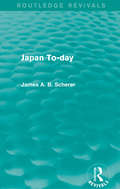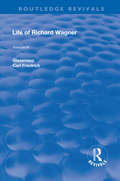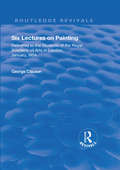- Table View
- List View
The Myth of Primitivism
by Susan HillerThis book explores the fusion of myth, history and geography which leads to ideas of primitivism, and looks at their construction, interpretation and consumption in Western culture. Contextualized by Susan Hiller's introductions to each section, discussions range from the origins of cultural colonialism to eurocentric ideas of primitive societies, including the use of primitive culture in constructing national identities, and the appropriation of primitivist imagery in modernist art. The result is a controversial critique of art theory, practice and politics, and a major enquiry into the history of primitivism and its implications for contemporary culture.
The Routledge History of Women in Europe since 1700 (Routledge Histories)
by Deborah SimontonThe Routledge History of Women in Europe since 1700 is a landmark publication that provides the most coherent overview of woman’s role and place in western Europe, spanning the era from the beginning of the eighteenth century until the twentieth century. In this collection of essays, leading women's historians counter the notion of ‘national’ histories and provide the insight and perspective of a European approach. Important intellectual, political and economic developments have not respected national boundaries, nor has the story of women’s past, or the interplay of gender and culture. The interaction between women, ideology and female agency, the way women engaged with patriarchal and gendered structures and systems, and the way women carved out their identities and spaces within these, informs the writing in this book. For any student of women’s studies or European history, The Routledge History of Women in Europe since 1700 will prove an informative addition to their studies.
Towards Coastal Resilience and Sustainability (The Dynamics of Economic Space)
by John Morrissey C. Patrick HeidkampCoastal zones represent a frontline in the battle for sustainability, as coastal communities face unprecedented economic challenges. Coastal ecosystems are subject to overuse, loss of resilience and increased vulnerability. This book aims to interrogate the multi- scalar complexities in creating a more sustainable coastal zone. Sustainability transitions are geographical processes, which happen in situated, particular places. However, much contemporary discussion of transition is either aspatial or based on implicit assumptions about spatial homogeneity. This book addresses these limitations through an examination of socio- technological transitions with an explicitly spatial focus in the context of the coastal zone. The book begins by focusing on theoretical understandings of transition processes specific to the coastal zone and includes detailed empirical case studies. The second half of the book appraises governance initiatives in coastal zones and their efficacy. The authors conclude with an implicit theme of social and environmental justice in coastal sustainability transitions. Research will be of interest to practitioners, academics and decision- makers active in the sphere of coastal sustainability. The multi- disciplinary nature encourages accessibility for individuals working in the fields of Economic Geography, Regional Development, Public Policy and Planning, Environmental Studies, Social Geography and Sociology.
A History of Egypt from the End of the Neolithic Period to the Death of Cleopatra VII B.C. 30: Vol. I: Egypt in the Neolithic and Archaic Periods (Routledge Revivals)
by E. A. BudgeSir E. A. Wallis Budge (1857-1934) was Keeper of the British Museum’s department of oriental antiquities from 1894 until his retirement in 1924. Carrying out many missions to Egypt in search of ancient objects, Budge was hugely successful in collecting papyri, statues and other artefacts for the trustees of the British Museum: numbering into the thousands and of great cultural and historical significance. Budge published well over 100 monographs, which shaped the development of future scholarship and are still of great academic value today, dealing with subjects such as Egyptian religion, history and literature. This volume, first published in 1901 as part of the Egypt and Chaldaea series, is the first of eight volumes by Budge dealing with different periods in the history of Egypt. The narrative begins with an account of Egypt and her people in the latter part of the Neolithic period, and ends with the description of her conquest by the Romans under Caesar Octavianus, B.C. 30. Budge considers the great excavations of the nineteenth century in the first volume and, alongside detailed illustrations, provides a fascinating analysis of the dynastic kings.
Manchuria: Its People, Resources and Recent History (Routledge Revivals)
by Alexander HosieFirst published in 1901, this volume emerged in the aftermath of the Russian invasion of Manchuria. Its author had been in charge of the British Consulate at Newchwang in Manchuria for two periods between 1894 and 1900. The book contains an account of journeys in Eastern and Northern Manchuria, followed by chapters on recent events in Manchuria along with its climate, people, administration and industry.
The Social Life of the Hebrews (Routledge Revivals)
by Edward DayFirst published in 1901, this study of the social life of the Hebrews considers both the time of the judges and the time of the monarchy. Written in a popularly scientific style, designed to appeal to students of ancient Middle East and biblical history as well as the general reader, this work details the social life and history of allied Semitic races, covering the period of time from the settlement of Canaan to the breakup of the Northern Kingdom in 722 BC.
The Souls of Black Folk: With "The Talented Tenth" and "The Souls of White Folk"
by Donald B. Gibson W. E. Du Bois Monica E. ElbertDu Bois' 1903 collection of essays is a thoughtful, articulate exploration of the moral and intellectual issues surrounding the perception of blacks within American society.
Women and Their Work (Routledge Revivals)
by Mrs Arthur LytteltonFirst published in 1901, this title lends insight into the position of English women in the workforce at the turn of the twentieth century. The conditions of women changed rapidly throughout the 1800s, leading to more varied choices in terms of career and lifestyle. However, this title also reveals the limited status of women even one hundred years ago, as Lyttleton urges that women must decide between a family life and a career. Women and Their Work will be of interest to students of Sociology, Women’s History, and Gender Studies.
A History of Egypt from the End of the Neolithic Period to the Death of Cleopatra VII B.C. 30: Vol. II: Egypt Under the Great Pyramid Builders (Routledge Revivals)
by E.A. Wallis BudgeSir E. A. Wallis Budge (1857-1934) was Keeper of the British Museum’s department of oriental antiquities from 1894 until his retirement in 1924. Carrying out many missions to Egypt in search of ancient objects, Budge was hugely successful in collecting papyri, statues and other artefacts for the trustees of the British Museum: numbering into the thousands and of great cultural and historical significance. Budge published well over 100 monographs, which shaped the development of future scholarship and are still of great academic value today, dealing with subjects such as Egyptian religion, history and literature. This volume, first published in 1902 as part of the Egypt and Chaldaea series, is the second of eight volumes by Budge dealing with different periods in the history of Egypt. The narrative ranges from the end of the 3rd Dynasty up to the close of the reign of Seānkh-ka-Rā, who was famous for the despatch of an expedition to Punt, and was the last king of the 6th Dynasty. This second volume deals with the Great Pyramid Builders of Egypt, and, alongside detailed illustrations, provides a fascinating analysis of the dynastic kings.
Electric Shock: From the Gramophone to the iPhone – 125 Years of Pop Music
by Peter DoggettAmbitious and groundbreaking, Electric Shock tells the story of popular music, from the birth of recording in the 1890s to the digital age, from the first pop superstars of the twentieth century to the omnipresence of music in our lives, in hit singles, ringtones and on Spotify. Over that time, popular music has transformed the world in which we live. Its rhythms have influenced how we walk down the street, how we face ourselves in the mirror, and how we handle the outside world in our daily conversations and encounters. It has influenced our morals and social mores; it has transformed our attitudes towards race and gender, religion and politics. From the beginning of recording, when a musical performance could be preserved for the first time, to the digital age, when all of recorded music is only a mouse-click away; from the straitlaced ballads of the Victorian era and the ‘coon songs’ that shocked America in the early twentieth century to gangsta rap, death metal and the multiple strands of modern dance music: Peter Doggett takes us on a rollercoaster ride through the history of music. Within a narrative full of anecdotes and characters, Electric Shock mixes musical critique with wider social and cultural history and shows how revolutionary changes in technology have turned popular music into the lifeblood of the modern world.
Japan and Her People: Vol. I (Routledge Revivals)
by Anna C. HartshorneFirst published in 1902, this volume emerged contemporaneously with the Anglo-Japanese Treaty and explored the nation of Britain’s newest allies from an American perspective. Anna Hartshorne took her readers from experiencing Japan as unreal to utterly normal. She provided a thorough traveller’s guide including the voyage and first impressions, major locations and Japan’s peoples, culture and history. This is presented in two volumes along with 50 illustrations.
Japan and Her People: Vol. II (Routledge Revivals)
by Anna C. HartshorneThis book provides an overview of Japan in late 19th century and its history. It also provides an insight of Japanese society as it moved from the traditional Edo period lifestyle towards industrialization and explores Japan's lifestyles, customs, culture, and everyday behavior.
Revival: Opera and Drama (Routledge Revivals)
by Carl Friedrich GlasenappThe second volume of Carl Friedrich Glasenapp's Life of Richard Wagner.
The Great Kosher Meat War of 1902: Immigrant Housewives and the Riots That Shook New York City
by Scott D. Seligman2020 American Book Fest Best Book Awards Finalist in the U.S. History category In the wee hours of May 15, 1902, three thousand Jewish women quietly took up positions on the streets of Manhattan&’s Lower East Side. Convinced by the latest jump in the price of kosher meat that they were being gouged, they assembled in squads of five, intent on shutting down every kosher butcher shop in New York&’s Jewish quarter. What was conceived as a nonviolent effort did not remain so for long. Customers who crossed the picket lines were heckled and assaulted, their parcels of meat hurled into the gutters. Butchers who remained open were attacked, their windows smashed, stocks ruined, equipment destroyed. Brutal blows from police nightsticks sent women to local hospitals and to court. But soon Jewish housewives throughout the area took to the streets in solidarity, while the butchers either shut their doors or had them shut for them. The newspapers called it a modern Jewish Boston Tea Party.The Great Kosher Meat War of 1902 tells the twin stories of mostly uneducated female immigrants who discovered their collective consumer power and of the Beef Trust, the midwestern cartel that conspired to keep meat prices high despite efforts by the U.S. government to curtail its nefarious practices. With few resources and little experience but a great deal of steely determination, this group of women organized themselves into a potent fighting force and, in their first foray into the political arena in their adopted country, successfully challenged powerful vested corporate interests and set a pattern for future generations to follow.
The Struggle for Persia (Routledge Library Editions: Iran #8)
by Donald StuartThis volume is an account of the journey the author made between Eastern Russia (via Tabriz) to Teheran at the turn of the twentieth century. This is not just a travelogue, however, but a lament for the loss of British “prestige” and power in the region to Russia.
Unpacking the Collection
by Rodney Harrison Anne Clarke Sarah Byrne Robin TorrenceMuseum collections are often perceived as static entities hidden away in storerooms or trapped behind glass cases. By focusing on the dynamic histories of museum collections, new research reveals their pivotal role in shaping a wide range of social relations. Over time and across space the interactions between these artefacts and the people and institutions who made, traded, collected, researched and exhibited them have generated complex networks of material and social agency. In this innovative volume, the contributors draw on a broad range of source materials to explore the cross-cultural interactions which have created museum collections. These case studies contribute significantly to the development of new theoretical frameworks to examine broader questions of materiality, agency, and identity in the past and present. Grounded in case studies from individual objects and museum collections from North America, Europe, Africa, the Pacific Islands, and Australia, this truly international volume juxtaposes historical, geographical, and cross-cultural studies. This work will be of great interest to archaeologists and anthropologists studying material culture, as well as researchers in museum studies and cultural heritage management.
Watching the Traffic Go By: Transportation and Isolation in Urban America
by Fotsch Paul MasonAs twentieth-century city planners invested in new transportation systems to deal with urban growth, they ensured that the automobile rather than mass transit would dominate transportation.<P><P> Combining an exploration of planning documents, sociological studies, and popular culture, Paul Fotsch shows how our urban infrastructure developed and how it has shaped American culture ever since. <P> Watching the Traffic Go By emphasizes the narratives underlying our perceptions of innovations in transportation by looking at the stories we have built around these innovations. Fotsch finds such stories in the General Motors "Futurama" exhibit at the 1939 World's Fair, debates in Munsey's magazine, films such as Double Indemnity, and even in footage of the O. J. Simpson chase along Los Angeles freeways. <P> Juxtaposed with contemporaneous critiques by Lewis Mumford, Theodor Adorno, and Max Horkheimer, Fotsch argues that these narratives celebrated new technologies that fostered stability for business and the white middle class. At the same time, transportation became another system of excluding women and the poor, especially African Americans, by isolating them in homes and urban ghettos.
Formosa Under the Dutch: Described from Contemporary Records with Explanatory Notes and a Bibliography of the Island (Routledge Revivals)
by William CampbellFirst published in 1903, this volume explored the history of Formosa (now Taiwan) under Dutch occupation between 1624 and 1661, along with shedding some light on its early history. As missionaries were again at work in Formosa, the author found it useful to understand the fate of the island’s previous Catholic colonisation. Part 1 is composed from the Oud en Niew Oost-Indian by Franҫois Valentyn and covers topography, trade and religion. Part 2 covers Catholic Missions to the Island and sheds some light on the issues they faced related to having no vernacular Bibles and other methods of conversion. This will be of particular interest to students and researchers of Catholic world conversion efforts under the Counter-Reformation, in comparison to similar efforts elsewhere in Asia such as Japan, China and India. Part 3 narrates the events which led up to, and culminated in, the nine months’ siege of Fort Zeelandia which ended the rule of the Dutch East India Company over what is now Taiwan.
Revival: A Handbook of Modern Japan (Routledge Revivals)
by Ernest W. ClementIn this book the author has intended to portray Japan as he finds it rather than as it was in the past. However, the past is not ignored as it would be both foolish and futile. It is noted whilst there are no parts of Japan, and very few of her people, entirely unaffected by the new civilization, yet there are still some segments which are comparatively unchanged by the new ideas and ideals. It is observed that although those who have been least affected by the changes are more in number than those who have been most influenced by the change, yet the latter are much more active and powerful than the former.
Revival: The Theatre (Routledge Revivals)
by Carl Francis GlasenappThird volume of Carl Francis Glasenapp's Life of Richard Wagner.
Scenes from the High Desert: Julian Steward's Life and Theory
by Virginia KernsJulian Steward (1902-72) is best remembered in American anthropology as the creator of cultural ecology, a theoretical approach that has influenced generations of archaeologists and cultural anthropologists. Virginia Kerns considers the intellectual and emotional influences of Steward's remarkable career, exploring his early life in the American West, his continued attachments to western landscapes and inhabitants, his research with Native Americans, and the writing of his classic work, Theory of Culture Change. With fluid prose and rich detail, the book captures the essence and breadth of Steward's career while carefully measuring the ways he reinforced the male-centered structure of mid-twentieth-century American anthropology.
The History of The Great Northern Railway: 1845 - 1902 (Routledge Revivals)
by Charles H. GrinlingPublished in 1903, this book provides a complete account of the origin and development of the Great Northern Railway Company from its inception to the year 1802, a period of around 60 years.
Japan To-day (Routledge Revivals)
by James A. SchererThis book, first published in 1904, aimed to provide an overview of the aspects of everyday Japanese life at the beginning of the twentieth century. This book will be of interest to students of history and Asian Studies.
Revival: Art and Politics (Routledge Revivals)
by Carl Francis GlasenappFourth volume of Carl Francis Glasenapp's Life of Richard Wagner.
Revival: Delivered to the Students of the Royal Academy of Arts in London, January 1904 (Routledge Revivals)
by George ClausenThe chapters in this volume were delivered at lectures to students of the Royal Academy of Arts in January 1904 by George Clausen, who was at that time Professor of Painting. He approaches the subject a number of ways, including specific masters, styles, methods, techniques, contexts and composition. The book offers a balanced introduction to the subject, and to the modern reader, an insightful glimpse at an approach to this evergreen topic as delivered over 100 years ago.
